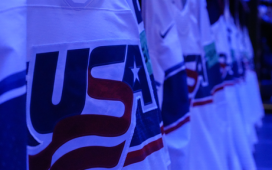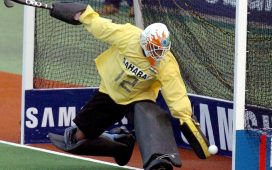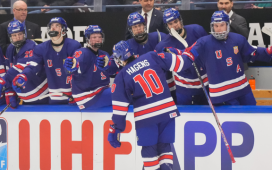Dustin Byfuglien underwent surgery to repair an ankle injury and will be sidelined for several months, which means any talk of returning to Winnipeg anytime soon is on hold. Given that news, the Jets could seek a quick fix on the blueline. But is that what’s best?

Since news came of Dustin Byfuglien’s personal leave from the Jets, during which time he’s reportedly weighing his options and potentially considering an early retirement, Winnipeg has taken a wait-and-see approach. There was no reactionary wheeling and dealing, no scrambling to add a piece and GM Kevin Cheveldayoff has been almost remarkably patient. His lone move has been the addition of Luca Sbisa, who was plucked away from the Anaheim Ducks as he went through the waiver wire.
But given the latest development in the Byfuglien saga, we might be inching closer to a change in approach from Cheveldayoff and Co.
On Wednesday, TSN’s Bob McKenzie reported that Byfuglien, 34, has gone under the knife to repair “unresolved issues” related to the high-ankle sprain he suffered last season. As you’ll recall, ‘Big Buff’ was sidelined twice last season with issues relating to his ankle, missing a combined 34 contests during the second half of the 2018-19 season. And as a result of the surgery, it sounds as though even if Byfuglien has a desire to return this season, he won’t be able to do so anytime soon. Following up on McKenzie’s report, TSN’s Darren Dreger noted Thursday that Byfuglien, who reportedly had the surgery last week in Minnesota, could need more than four months to recover. Do the math on that and you get the picture: if Byfuglien is coming back, it won’t be before the final month or even weeks of the campaign.
And that brings us to the Jets’ blueline, which has to this point been held together by little more than Josh Morrissey and a ragtag group of rearguards who wouldn’t play more than second-pairing minutes elsewhere.
Prior to the news that Byfuglien would be sidelined for several months, there was something of a necessity for the Jets to be patient, if only because the cap situation dictated as much. Though he has been suspended by the team, which Cheveldayoff called a “procedural” move, the potential for Byfuglien’s return made it so Winnipeg had to be cautious, not using the cap space that would be required to get the big blueliner back into the lineup if he decided to play this season. If they had done so, the Jets ran the risk of a financial logjam that could have resulted in a forced cap-clearing trade upon Byfuglien’s return. And while that risk still exists, it’s significantly lessened with the knowledge that any potential playing time for Byfuglien this season could be limited to mere weeks.
The result? The Jets, realistically, could start exploring ways to use the cap space that had previously been reserved for Byfuglien. In fact, Winnipeg could scour the trade market for a mid-range defender earning upwards of $4-million per season and almost assuredly add him to the lineup without a corresponding move or ensuring that it’s a dollar-for-dollar swap. That’s the good news. The bad news is that finding that player is going to be remarkably difficult. While veteran options such as Jack Johnson and Brent Seabrook and Marc Staal are certainly among those for whom a trade could be worked out, none of those three defenders are going to move the needle significantly for the Jets and each comes with contract baggage that Winnipeg likely wouldn’t want to assume.
But that’s not to say there aren’t any defenders who fit the bill. There are. Even a few who might be able to be pried away from their respective clubs. The Los Angeles Kings, who are ripe for a rebuild, might be able to be persuaded to part ways with veteran Alec Martinez, who is only two years away from the end of his pact and carries a $4-million cap hit. Likewise, Islanders defenseman Nick Leddy has fallen out of a top-pairing role in New York and makes a manageable $5.5 million per season. Nabbing him would probably require some cap gymnastics, but it’s not out of the realm of possibility. Then there are others, such as the Flames’ Travis Hamonic or T.J. Brodie, who could likewise be acquired for the right price, especially with Calgary potentially seeking a minor shakeup to wake up its roster.
However, trades for any of those players, or really any defender who has potential be a difference-maker, pose another problem for the Jets.
As it stands, Winnipeg entered this season primed to take a step back, the result of talent lost in the off-season and a blueline that had already been weakened by the departures of Tyler Myers and Jacob Trouba before Byfuglien took his leave. The Jets have played like a team that is going to take that step backwards, too. With the opening month of the season nearly in the books, Winnipeg is 6-7-0 and we’re beginning to get a crystal-clear picture of a team that isn’t prepared to compete for anything beyond a wild-card spot this season. And if that is the case, if the Jets aren’t going to contend and are no more than potential first- or second-round fodder, is there really a need to acquire anyone at all?
Undoubtedly, that’s not going to sit well with many in Winnipeg, but the reality is that a stop-gap option now is only going to cost the Jets picks and prospects and possibly even a roster player with whom they didn’t have designs on parting. There were the Nikolaj Ehlers rumors during the off-season, but his start to the season is proof positive of how misguided shipping him out would have been. Jack Roslovic has been talked about a trade option, but he’s keeping offensive pace with Kyle Connor and Blake Wheeler right now. And giving up futures for help seems misguided, particularly when the Jets’ draft and develop model is what led them to their most recent successes. No reason to do anything to put that model at risk.
So, what now? Maybe the answer is nothing at all, maybe it’s for Cheveldayoff not to stray from his current approach and continue as he has through October. There will be time to tackle the blueline situation, which has become far more complicated than the Jets had expected, in the off-season. Then, Winnipeg will have a clearer picture of who will be around, the chance to kick some tires on the open market and less need to make a panicked deal in search of a quick fix. And while that isn’t what many want to hear, nor will it be an answer all that popular with those who want to see the Jets win now, it’s probably the right one.
Want more in-depth features, analysis and an All-Access pass to the latest content? Subscribe to The Hockey News magazine.








